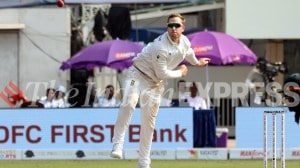Power Play
Strong reactions from domestic quarters have emerged after India’s decision to back the IAEA resolution against Iran’s nuclear pro...

Strong reactions from domestic quarters have emerged after India’s decision to back the IAEA resolution against Iran’s nuclear program. Many are rooting for sentiments by evoking India’s legacy of good relations with Iran, or by terming the decision as a clear sign of obeisance to USA. This rhetoric is a trivialisation of a rational, if a path breaking move. International diplomacy is most fruitful when it is self-interests, and not sentiments that guide a country’s actions.
More than trade, environment and justice, it is energy that will be the foundation ground for all international diplomacy in the future. For all its mounting energy needs, India stands to be the largest beneficiary if it joins hands with the US. We are already facing a severe shortfall in power; even our metros have to bear huge load sanctions in peak season. While it was always obvious that we need to set up additional power plants, now it is becoming clearer that we shall do well to use nuclear energy, rather than fast depleting oil or gas resources for our power plants.
Prime Minister Manmohan Singh gained an assurance from the US of full nuclear cooperation for civilian use during his US visit in July this year. However, many US Congressmen were opposed to amending specific US domestic laws in order to give these special concessions to India. Having sided with US on the Iran issue, India has sent just the right signals to the opposition in the US Congressmen, besides firmly putting the ball back in US’ court. Reciprocity works as grease in international relations and we ought not to expect to gain if we are not prepared to give something in return. For last thirty years, US had denied us any support or cooperation for our nuclear power installations. Today we have an opportunity to turn the tide around and gain not just full cooperation, but also access to cutting edge nuclear technologies that will help us build next-generation of cheaper and safer nuclear power plants. We must seize the moment if we are to serve our own interests best.
In comparison, Iran remains a sticky ground for building our energy plans on. The proposed Iran-India gas pipeline is an enormously fragile project and it would take little less than divine intervention to see this project through.
Nomination puzzle
Animated clamour Juries related to Indian film industry are almost always flirting with controversies, whether they are selecting films for National Awards or Oscar nomination. In the latest episode, Indian film industry is torn into camps that are either fighting or defending nomination of Paheli for Oscars, as selected by a jury composed by Film Federation of India. It is upsetting to see our producers and directors bickering over Paheli’s selection, rather than closing their ranks behind the jury’s verdict.
The top filmmakers of the world set up camps in Beverly Hills to promote and lobby for their country’s films to get Oscars, and here we are seeing our own film fraternity raising pointers over a selection of its own. The Oscar Academy’s guidelines for selection of films by countries recommend selection of a film which is a representation of the country’s own culture, apart from satisfying the general standards of cinematic excellence. It is clear to see that Paheli meets the criteria well.
Since it is always either the jury or the selection criteria under attack, the industry might want to make changes to selection process itself. In Spain, for example, a democratic system for Oscar selection involves a three-member senior jury short listing 3 films. A 1000-member electorate then polls for the final selection which clearly leaves no room for pointing a finger.
In the race
After Cricket and Tennis, Motorsport is one arena where many Indians have the potential to make their mark at a global level. In Narain Karthikeyan, Karan Chandok and the budding Armaan Ibrahim, we have a team of talented young racers. While the most-popular F1 race is a contest between car racing teams with little regard for nationality, the recently launched A1 series is a sporting contest between 25 national teams. I felt proud to see a Team India car contesting in the inaugural race at Brands Hatch circuit in England.
Unfortunately, this is also one sport which requires lots of money to support its racers. I have learnt that Narain Karthikeyan has been told by his employer Team Jordan that they cannot sponsor him anymore. Thankfully, Gautam Singhania of Raymond has come forward to help Karthikeyan with a pledge of half-a-million dollars. But this will barely be enough to sustain him for long.
At the A1 event, we were in the company of several rich NRIs with the likes of L.N. Mittal and Gokul Binani coming out to cheer for Karan Chandok, driving for Team India. Unfortunately the car suffered a technical snag and failed to take off, ending in a disappointment for the Indian contingent. But now everyone is looking forward to the next race scheduled in Germany. Team India for A1 is sponsored by South African electronics major Sahara Computers. It would be a pleasure to see other well-heeled NRIs coming forward to sponsor talented Indian sportspersons, who are only held back by lack of money.
(The writer is a Congress MP in Rajya Sabha. Send him your feedback at shuklarajeevgmail.com)





- 01
- 02
- 03
- 04
- 05


























